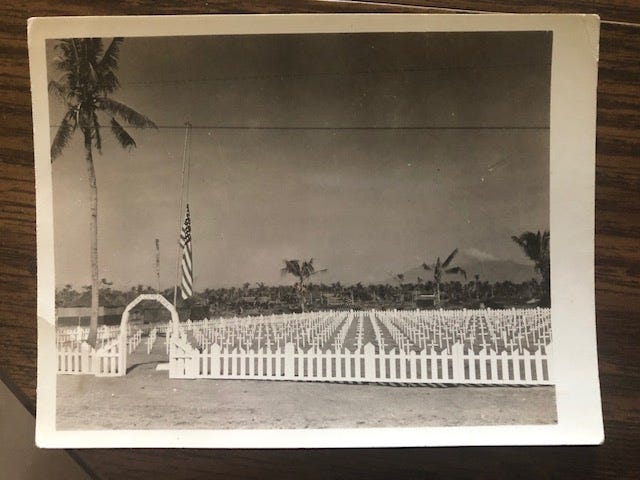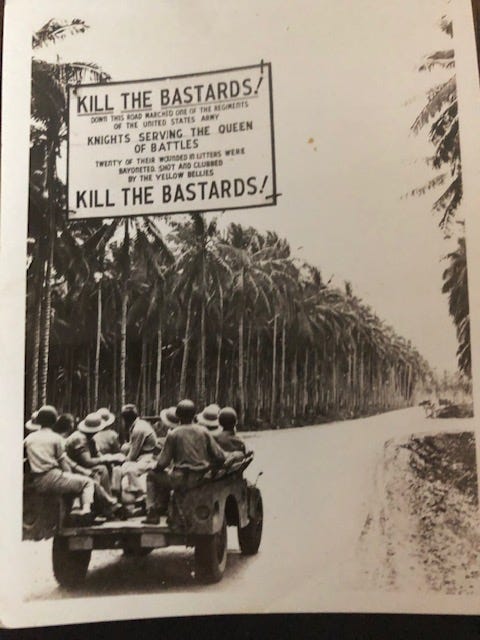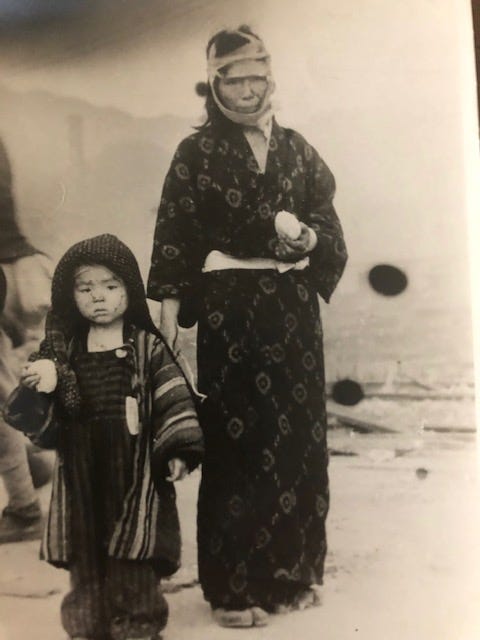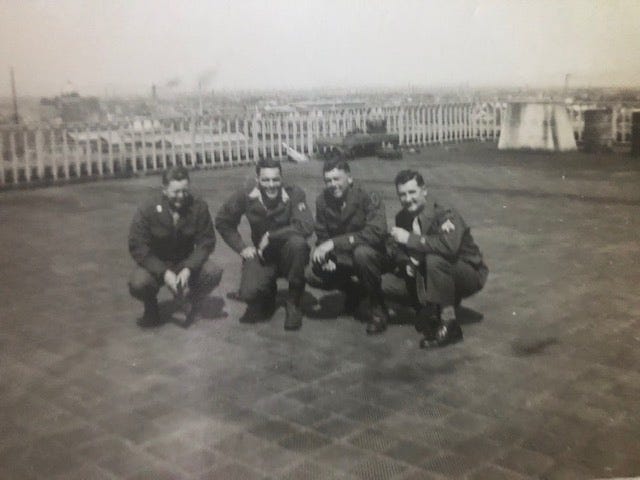Four years ago I received an unexpected package from an unexpected source. The return address was Zephyrhills, Florida, and I recognized the name of the sender as a cousin I haven't seen in six decades.
The package was filled with black-and-white photos, along with a brief typewritten letter from cousin Bill, explaining that my dad's youngest brother, Clarence, had taken these during his service in World War II.
In 2018, Bill had unexpectedly sent Clarence's November 7, 1946 honorable discharge document from the 25th Infantry Regiment of the U.S. Army.
When my siblings and I were growing up, our families visited regularly. In later years, after I had moved away, and Dad had died, my brief visits to Clarence's home with a young family of my own didn't focus on his military service. I knew he was born in 1912 on my grandparents' Woodbury County farm, but his years as a young adult were obscured by time.
Bill's letter filled in a few basic details: By September 1944, when Clarence was drafted, he was married, living in California, and working at an aircraft factory. He completed his basic training at Ft. Leonard Wood in Missouri, along with his Signal Corp training. He shipped out to the Philippines. and later his regiment was sent to Japan during the occupation. His unit spent time in Hawaii on his way home.
I retrieved his honorable discharge document from a brown manilla envelope in my files. According to the document, he returned home to the Camp Beale, California Separation Center.
When Bill mailed it to me in 2018, he never mentioned this treasure-trove of photos. The 275+ prints range in size from 2" x 3" to 4" x 6". Only a fraction contain a faintly written note describing the scene or location. I was unprepared for what I saw.
The setting for this photo appears to be the Grand Avenue Viaduct in Sioux City, a long, elevated structure built in 1936 over the Floyd River valley, and the extensive network of railroad tracks supporting the stockyards. Clarence likely was home to see his parents before shipping out. Other photos feature places of transit: the Yokohama Station depot; a hotel flying an American flag, with the notation, "Hotel at Osaka where I stayed." Another captured a view of the cable car track at Kobe, as well as Mt. Fujiyama, Japan, at 12,388 feet, the tallest mountain in Japan, and a prominent landmark for U.S. bombers.
Other scenic photos are labeled "Rest Camps." One is a swimming pool at Rest Camp, Nikko, Japan; this one showed a "Recreation Room at Rest Camp, Nikko," with a few couples dancing. In another photo, identified as Kanaya Hotel, a Rest Camp, just north of Tokyo in the mountains, Clarence poses with another soldier. One other rural setting included Clarence and another American soldier, both shirtless and holding beverages with a Japanese man in the middle. It was labeled "Picnic in mountains, Kobe". Kobe was the sixth largest city in Japan at the time, and the second largest port. The man in the middle could have been Nisei, a second generation Japanese American; Bill had mentioned that Clarence had made friends with Nisei soldiers, and learned to speak some Japanese.
More urban social settings highlight the Red Cross Canteen in Yokohama, the Red Cross and Coffee Shop, and the Cabaret International in Osaka.
Many photos documented military events. One captured the 25th Division Band marching in a parade for Gen. Eisenhower in Osaka. Another shows a large building, with soldiers standing in formation on its steps, with the note "General Mullins when Eisenhower visited Japan." One more mentions Gen. Buckner's grave at Okinawa; after checking, I learned he was key figure in the Pacific Theater, killed in the closing days of the Battle of Okinawa.
This photo shows Gen. MacArthur's headquarters, Tokyo, Japan, decorated in holiday lights. Imagine how lonely it must have been for U.S.soldiers serving during the holidays, so far from home.
The photo collection includes many street shots. One has the notation, “Black Market, Tokyo”. Black markets emerged after the War, due to collapse in distribution and rationing system. Another one captures a view of a city street, with pedestrians; it appears "normal", but two of the Japanese women were wearing white face masks.
Not surprisingly, other photos are more disturbing, including a series of photos of bombed buildings; one shows piles of helmets at a bombed factory. Some photos reveal armed soldiers and tanks, with bodies lying in the streets. In Nagasaki, Japan, survivors appear to be resting on the ground, with soldiers sitting nearby. Two soldiers pose in another, with four shirtless, emaciated young Japanese prisoners. Two Japanese soldiers, appearing deceased, lie in an uncovered grave.
As I tried researching the history behind the photos, I found that more than 100,000 Japanese were killed on a single night in the U.S. firebombing of Tokyo in March 1945. The weapon of destruction: conventional napalm bombs that reportedly covered the streets with charred bodies.
Consider this striking photo with a huge sign above the palm-tree-line road:
In another photo, two soldiers, with their backs to the camera, were walking a nearly naked Japanese man at gunpoint, as he clasped his hands behind his head. Another chilling photo displays a dead or unconscious man, with barrel of a gun pointed down at him by a soldier (pictured waist-down). One photo was labeled: "Atom Bomb results, Hiroshima, Japan, 1945." Another noted: "Invasion of Saipan, April 1944."
Additional photos depict the drama of a displaced people, who became the collateral damage of war: this family riding oxen with their few belongings. In another poignant photo, a woman with a large contusion on her cheek is breast-feeding an infant; the baby's scalp appears covered in soot or grime. In a second photo below, a young boy and his
mother: are they holding bread in their hands?
War is hell.
Feeling the Weight of History
My uncle returned to the U.S. in his mid-30s with these disturbing and dehumanizing images imprinted upon him. He was only one of countless others to experience this upheaval. When he arrived in California, he found his wife had divorced him. Returning home to Iowa, he met and married Wilma in 1950; she was raising two grade-school-age sons, Bill and Bob., after her marriage had ended. In 1952, Clarence and Wilma had a son, Gary.
I'd like to think the next 20 years were good years for them. Clarence put his farm background to good use working for the well-known Moorman Feed, and Wilma was busy with the three boys. They're part of many family reunion memories in Sioux City parks, as well as Sunday afternoons with our dads' extended family at my grandparents. During one reunion Clarence gave my older brother a couple of quarters to help keep tabs on Gary, an active, brown-eyed toddler. I recall Clarence lovingly combing Gary's curly black hair. Years later, after Bill and Bob outgrew visits to our farm, Gary still loved to come. We climbed on the chicken house roof, and plucked mulberries from the trees above; later, at dusk, we chased fireflies.
Although Clarence lived until 1995, I know that a huge hunk of his heart died on May 22, 1977, when Gary tragically died at age 26.
After Aunt Wilma passed away in 2004, Bill, who had left Iowa decades earlier, ended up with Clarence's World War II photos. and honorable discharge papers. He has never married. And, although we haven't seen one another, or talked in decades, he's entrusted me with this family history closely intertwined with one of the most historic chapters of our nation. These photos must belong in a museum collection, right? This 3-day weekend is more reminder that I need explore this before another Memorial Day passes.
Honoring Unrecognized Patriots
Buried beneath all the hubbub of this 3-day Federal holiday is the original intent: To honor the fallen veterans of our nation's wars.
As a kid growing up on the farm in Woodbury County, many of our out-of-state relatives would return to decorate the graves, and attend "Decoration Day" services.
I'm headed to Sioux City ahead of this Memorial Day to retrace this tradition at family cemeteries, remembering my parents, grandparents, and great-grandparents who left a storied legacy to me, my siblings, and our children.
This year, I'll add a different cemetery to my stops, visiting the graves of Uncle Clarence and Aunt Wilma. Like so many other soldiers, he left his home, wife, parents, siblings, and friends to serve his country a world away. After witnessing the horrors of war, he returned, like so many of his comrades, to pick up the pieces of his young life. But he was one of the lucky ones: he survived to start his life over again.
We owe them all a deep debt of gratitude
.
.











Thank you for sharing.
Wonderful tribute to your relative, and so many who have experienced warfare.